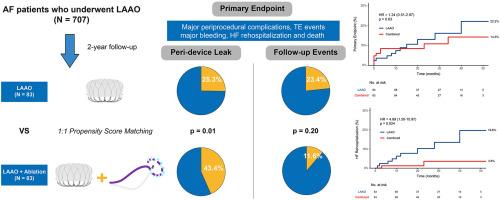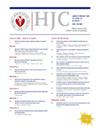Combining catheter ablation and left atrial appendage occlusion in high-risk patients with atrial fibrillation: a propensity score-matched analysis
IF 3
3区 医学
Q2 CARDIAC & CARDIOVASCULAR SYSTEMS
引用次数: 0
Abstract
Background
The safety and efficacy of a combined approach of catheter ablation (CA) and left atrial appendage occlusion (LAAO) compared to LAAO alone remain unknown.
Methods
Patients with atrial fibrillation (AF) at increased stroke risk who underwent LAAO were divided into either combined (CA and LAAO) procedures or LAAO alone group. Propensity score matching was utilized to balance baseline characteristics. The primary endpoint of the study was a composite of death, thromboembolic events, major bleeding, heart failure (HF) rehospitalization, and major periprocedural complications.
Results
A total of 707 AF patients who underwent LAAO were included. After 1:1 propensity score matching, 166 patients who underwent LAAO alone (n = 83) or the combined procedure (n = 83) were analyzed. Successful LAAO was achieved in all (100%) patients, with a low incidence of periprocedural complications in both groups (2.4% vs. 4.8%, LAAO vs. combined, p = 0.68). The incidence of peri-device leak post-LAAO was significantly higher in the combined group (25.3% vs. 43.4%, p = 0.01). After a median follow-up of 2 years, there were no significant differences in the rates of the primary composite endpoint between the two strategies (22.2% vs. 14.3%, HR: 1.24 [95% CI: 0.51–2.97], p = 0.63). However, the rate of HF rehospitalization was significantly lower in the combined group (19.6% vs. 3.6%, HR: 4.89 [95% CI: 1.50–15.97], p = 0.024).
Conclusions
Combining CA and LAAO in a “one-stop” approach is safe and brings additional benefits in relieving symptoms of heart failure, although peri-device leak was more common compared to LAAO alone.

对高危心房颤动患者联合使用导管消融术和左心房阑尾闭塞术:倾向评分匹配分析
背景:导管消融术(CA)和左心房阑尾封堵术(LAAO)联合治疗与单纯 LAAO 相比,其安全性和有效性仍是未知数:方法:将中风风险较高且接受 LAAO 的心房颤动(房颤)患者分为联合手术(CA 和 LAAO)组或单纯 LAAO 组。采用倾向评分匹配法平衡基线特征。研究的主要终点是死亡、血栓栓塞事件、大出血、心力衰竭(HF)再住院和主要围手术期并发症的综合结果:共纳入了707名接受LAAO手术的房颤患者。经过1:1倾向评分匹配后,对166名单独接受LAAO(83人)或联合手术(83人)的患者进行了分析。所有患者(100%)都成功进行了 LAAO,两组患者的围手术期并发症发生率都很低(2.4% 对 4.8%,LAAO 对联合手术,P=0.68)。LAAO术后器械周围渗漏的发生率在联合组中明显较高(25.3% 对 43.4%,P=0.01)。中位随访 2 年后,两种策略的主要复合终点发生率无显著差异(22.2% 对 14.3%,HR:1.24 [95% CI:0.51-2.97],P=0.63)。然而,联合组的心房颤动再住院率明显降低(19.6% vs. 3.6%,HR:4.89 [95% CI:1.50-15.97],P=0.024):结论:"一站式 "联合 CA 和 LAAO 是安全的,并能在缓解心衰症状方面带来额外的益处,尽管与单独 LAAO 相比,器械周围渗漏更为常见。
本文章由计算机程序翻译,如有差异,请以英文原文为准。
求助全文
约1分钟内获得全文
求助全文
来源期刊

Hellenic Journal of Cardiology
CARDIAC & CARDIOVASCULAR SYSTEMS-
CiteScore
4.90
自引率
7.30%
发文量
86
审稿时长
56 days
期刊介绍:
The Hellenic Journal of Cardiology (International Edition, ISSN 1109-9666) is the official journal of the Hellenic Society of Cardiology and aims to publish high-quality articles on all aspects of cardiovascular medicine. A primary goal is to publish in each issue a number of original articles related to clinical and basic research. Many of these will be accompanied by invited editorial comments.
Hot topics, such as molecular cardiology, and innovative cardiac imaging and electrophysiological mapping techniques, will appear frequently in the journal in the form of invited expert articles or special reports. The Editorial Committee also attaches great importance to subjects related to continuing medical education, the implementation of guidelines and cost effectiveness in cardiology.
 求助内容:
求助内容: 应助结果提醒方式:
应助结果提醒方式:


